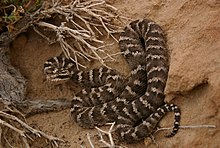en
names in breadcrumbs


Ploskolebec zakavkazský (Gloydius intermedius) je jedovatý had z čeledi zmijovitých, vyskytující se ve střední až severní Asii. Dorůstá délky asi 40 centimetrů, ve vzácnějších případech 60 centimetrů.
Tento had se vyskytuje především ve stepních biotopech, nejčastěji suchých. Loví malé ptáky, drobné savce a ještěrky. Je živorodý, neklade vejce. Samice rodí mláďata na podzim, může jich být až 20. Jed ploskolebce zakavkazského zatím nebyl podrobně zkoumán, má však zřejmě podobné účinky, jako zmijí jed.
Ploskolebec zakavkazský (Gloydius intermedius) je jedovatý had z čeledi zmijovitých, vyskytující se ve střední až severní Asii. Dorůstá délky asi 40 centimetrů, ve vzácnějších případech 60 centimetrů.
Gloydius intermedius is a venomous pitviper species endemic to northern Asia. Three subspecies are currently recognized, including the nominate subspecies described here.[3]
Gloyd and Conant (1990) reported examining subadults and adults of G. intermedius that were 33.5–71 cm (13.2–28.0 in) in total length. Nikolsky (1916) mentioned that some individuals may reach as much as 78 cm (30.5 in) in total length. The body is relatively stout, and the snout is not upturned.[2]
The scalation includes 7 supralabial scales, 23 rows of keeled dorsal scales at midbody, 149-165 ventral scales, and 32-48 subcaudal scales.[2]
The color pattern is variable, but generally consists of 28-45 dark subquadrate dorsal blotches or crossbands that usually extend down the flanks as far as the first or second scale rows. Between these blotches are irregular light areas. A dark brown to black postorbital stripe is present, extending from the eye back to the angle of the jaw, outlined by a light line above, and by cream-colored supralabial scales below.[2]
Common names for G. intermedius include Central Asian pit viper, intermediate mamushi, Mongolian pit viper,[2] Central Asian pitviper.[4]
G. intermedius is found in southeastern Azerbaijan, northern Iran, southern Turkmenistan, northwestern Afghanistan, southern Russia, Korea, northwestern China and Mongolia. The type locality given by Stejneger (1907) is "Governm. Irkutsk, East Siberia." Golay et al. (1993) give "Yesso (= Esso) Island, banks of Amur River and Khinggan (= Hinggan Ling) Mountain Range."[1]
The subspecific name, stejnegeri, is in honor of Norwegian-born American herpetologist Leonhard Stejneger.[5]
 Gloydius intermedius, Gobi Desert, Mongolia Common names: Central Asian pit viper, intermediate mamushi, Mongolian pit viper, .
Gloydius intermedius, Gobi Desert, Mongolia Common names: Central Asian pit viper, intermediate mamushi, Mongolian pit viper, . Gloydius intermedius is a venomous pitviper species endemic to northern Asia. Three subspecies are currently recognized, including the nominate subspecies described here.
Gloydius intermedius es una especie de serpiente venenosa de la familia Viperidae. Se distribuye por Asia central. Se reconocen tres subespecies.[2]
En 1990, Gloyd y Conant reportaron que los adultos y subadultos estudiados alcanzaban entre 33.5 y 71 cm de longitud. En 1916, Nikolsky mencionó que algunos individuos podían alcanzar hasta 78 cm de longitud. El cuerpo es relativamente robusto y su boca no está curvada hacia arriba. La escamación incluye: 7 escamas supralabiales, 23 filas de escamas dorsales quilladas a mitad del cuerpo, de 149 a 165 escamas ventrales y de 32 a 48 escamas subcaudales.
El patrón de colores es variable, aunque generalmente consiste en 28 a 45 manchas dorsales o bandas cruzadas que generalmente se extienden bajo los flancos hasta la primera o segunda fila de escamas. Entre estas manchas están áreas irregulares más claras. Está presente una línea postorbital de color que va de chocolate oscuro a negro, extendiéndose desde la parte posterior del ojo hasta el ángulo de la mandíbula esbozada por una línea clara superior y por escamas supralabiales inferiores color crema.
Encontrada en el sureste de Azerbaiyán, el norte de Irán, el sur de Turkmenistán, noroeste de Afganistán, el sur de Rusia, noroeste de China y Mongolia. La localidad tipo dada por Stejneger en 1907 es Irkustk en Siberia oriental. Golay y col. (1993) mencionan la isla de Yesso, los bancos del río Amur y la cordillera del Gran Khingan (Hinggan Ling).
Gloydius intermedius es una especie de serpiente venenosa de la familia Viperidae. Se distribuye por Asia central. Se reconocen tres subespecies.
Gloydius intermedius Gloydius generoko animalia da. Narrastien barruko Viperidae familian sailkatuta dago.
Gloydius intermedius Gloydius generoko animalia da. Narrastien barruko Viperidae familian sailkatuta dago.
Gloydius intermedius est une espèce de serpents de la famille des Viperidae[1].
Cette espèce se rencontre[1] :
Gloydius intermedius[6] este o specie de șerpi din genul Gloydius, familia Viperidae, descrisă de Strauch 1868.[7][8] Conform Catalogue of Life specia Gloydius intermedius nu are subspecii cunoscute.[7]
|access-date= (ajutor)Mentenanță CS1: Nume multiple: lista autorilor (link) Gloydius intermedius este o specie de șerpi din genul Gloydius, familia Viperidae, descrisă de Strauch 1868. Conform Catalogue of Life specia Gloydius intermedius nu are subspecii cunoscute.
Gloydius intermedius là một loài rắn trong họ Rắn lục. Loài này được Strauch mô tả khoa học đầu tiên năm 1868.[2]
Gloydius intermedius là một loài rắn trong họ Rắn lục. Loài này được Strauch mô tả khoa học đầu tiên năm 1868.
中介蝮(学名:Gloydius intermedius)为蝰科亚洲蝮属的爬行动物,俗名七寸子、七寸蛇、麻七寸、扎嘎勒卖图.毛盖。分布于亚洲中部俄罗斯、蒙古以及中国大陆的山西、内蒙古、陕西、甘肃、青海、宁夏、新疆等地,多生活于北疆,多栖息于海拔900-1650米低山石隙或灌丛。其生存的海拔上限为4000米。[1]